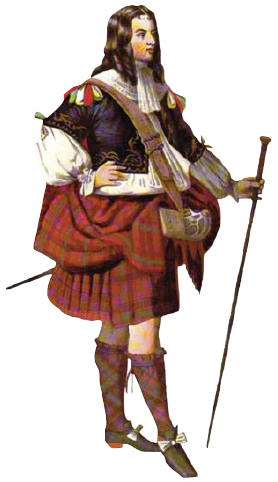
THE KILT and the tartan are not only Scotland’s national dress, but unquestionably form the most distinctive and most widely recognised national dress in the world. Strictly speaking the kilt began as a form of Highland dress and is often believed to belong only to that part of Scotland. Yet, while for a time this might arguably have been true, its claim to be the legitimate national dress for all Scots has a very substantial foundation.
Scottish dress shares many cultural similarities with folk dress elsewhere in the world insofar as what was once ordinary working clothing has over the years been formalised and embellished to turn it into a ceremonial dress suitable for high days and holy days. In that respect it is no different from German lederhosen or Texan cowboy shirts and blue jeans, for example. In short, it is an outward expression of the wearer’s historical and cultural identity and its very distinctiveness encouraged its adoption as a symbol of not just Highland but Scottish identity a surprisingly long time ago.
In popular myth there is something called the Highland Line, identified with the great geological fault slashing diagonally across Scotland from Dumbarton Rock on the River Clyde to Dunottar Castle on the East Coast just below Aberdeen. Those living to the north of this line are held to be the true Highlanders, the original wearers of the kilt and tartans, while those to the south of it are Lowlanders blessed with only the most tenuous entitlement to wear the tartan and none at all to wear the kilt. In reality history is rarely so simple.
Before the Wars of Independence culminating in Robert the Bruce’s great victory at Bannockburn in 1314, there is little evidence of such a split. There were rugged parts of Scotland and less rugged parts of Scotland, but neither the English kings who coveted it nor the Scottish kings who defended it ever regarded it as two parallel but different realms.
When King Alexander III tumbled over a cliff in 1286, leaving no obvious heir, the various claimants to the empty throne appealed to Edward I of England for arbitration. Edward duly judged the case honestly in favour of John Balliol, but also took the opportunity to declare himself Scotland’s feudal overlord. The Scots were unimpressed and refused to be intimidated, but it took nearly twenty years of bloody warfare to settle the matter. Sadly, for much of that time the English were the least of the Bruce’s worries. Before he could lead the Scots army to victory at Bannockburn he first had to fight and win a vicious civil war against the many supporters of the Balliols, chiefly led by the Comyns (or Cummings) in the North and the MacDougalls in the West.
Their lands, as it happened, stretched in a great arc from Lorne through Lochaber, Moray and Badenoch to the Buchan coast of the North East, and so included most of what would later become considered as the Highlands. Thus the eclipse of the Comyn lords of Lochaber and Badenoch effectively disenfranchised the Highlands in a Scotland thereafter dominated by the Bruces and their Stewart successors.
At the same time the growing commercial importance of the thriving East Coast ports meant that the hinterland (the Highlands) lacking both economic and political clout, steadily became marginalised so that by the seventeenth century there was indeed a Highland line, of sorts. It was always nevertheless a very indeterminate line and it is instructive to note that when the very last Scots Army was raised in 1745 the regiments of the Athole Brigade raised from amongst the Perthshire glens, the Gordons from Strathbogie and Strathdon, and the Farquharsons from Deeside were considered not as Highlanders but as part of the Lowland Division.

This elegant Highland gentleman of the seventeenth century in another painting by McIan may look unlikely, but is rather less flamboyantly dressed than a contemporary portrait of Sir Mungo Murray by John Michael Wright.
It was a similar story with language and if Scots, a tongue in some ways more akin to Flemish and German than to English, became predominant in the east-coast towns, it was still a different matter in the countryside and a form of Gaelic (Buchan Gaelic) was still being spoken alongside Doric in the supposedly lowland North East in the memory of the author’s grandparents!
The use of the plaid by the common people was still ubiquitous all over Scotland when the political landscape changed completely in 1707. In that year, by a mixture of blackmail, bribery and outright coercion England, desperate for Scottish soldiers to maintain a bloody and ruinously expensive war against France, forced through an act of Union; henceforth Scotland would be ruled from Westminster rather than Edinburgh. However, although the Scots Parliament reluctantly acquiesced in its own dissolution it was a deeply unpopular move in the country at large. Scotland was now proclaimed to be North Britain and in response its people turned to ostentatiously displaying the tartan as a defiant affirmation of their Scottish identity.
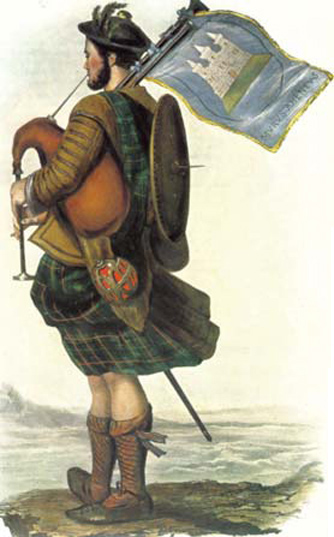
A reasonably convincing interpretation by McIan of a Highland piper wearing a conventional mid-seventeenth-century doublet.
This was most conspicuously seen during the last Jacobite Rising in 1745. When Bonnie Prince Charlie landed in the West Highlands, his first followers were, naturally enough, Highland clansmen, but by the time his army left Edinburgh on the famous march to Derby at least half of them were Lowland Scots. Nevertheless most wore Highland clothes, spelled out in an edict by Lord Lewis Gordon, the rebel commander in the North East of Scotland, requiring recruits to be ‘well cloathed, with short cloathes, plaid, new shoes, and three pair of hose.’ Other Jacobite officers enthusiastically followed suit and even the cavalry had tartan jackets or at the very least tartan scarves or tartan-mounted shoulder belts.
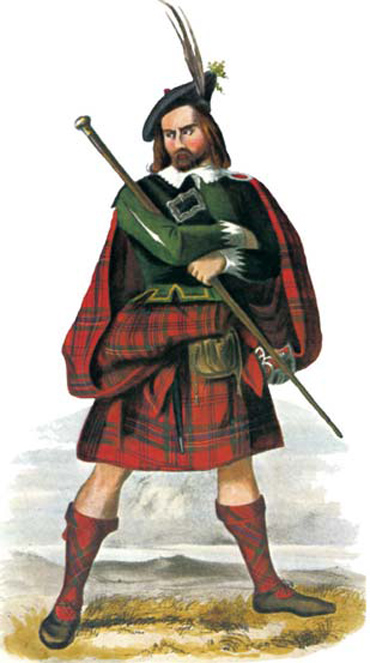
Fine study by McIan of a seventeenth-century Highland chieftain in a belted plaid.
From a practical point of view this was a sensible enough idea. By dressing everyone, or at least nearly everyone, in tartans and blue bonnets the army was provided with a very distinctive uniform at little trouble or cost. It did not matter that one man wore a red tartan jacket or plaid and the man standing next to him a green one; they were both in tartan and easily distinguished from their red-coated foes. It also did wonders for esprit de corps as all of them strutted around broadcasting their membership of the Highland Army that had demolished Johnnie Cope’s Redcoats before breakfast. Nevertheless, it was more than a matter of simple convenience or of creating the impression that the undernourished children of the Edinburgh slums were ferocious Highland warriors; it was also a political statement.
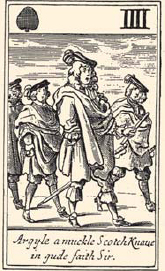
The Marquess of Argyle depicted on a seventeenth-century playing card. Like the other Scots in the deck, he and his companions are identified as Scots by their bonnets and plaids.
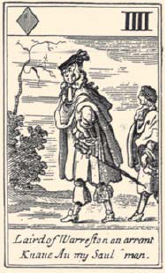
Johnstone of Wariston; another playing-card illustration depicting a Lowland gentleman in plaid and blue bonnet.
Prince Charles Edward Stuart was intent on making good his father’s claim to the throne of the three kingdoms of Britain, but most of those who followed his banner from choice were equally intent on seeing an end to the Union and on re-asserting Scotland’s independence. Not for nothing did some of them carry broadswords bearing the inscription ‘Scotland and No Union!’ Their choice of Highland dress, whether it was the full fig of belted plaid, broadsword and targe or just a tartan jacket and a rusty bayonet was therefore a conscious display of their Scottish identity. Consequently, after Culloden a thoroughly rattled British government promulgated what is generally referred to as the Disarming Act. There had been other disarming acts before, all of which hoped to ban the use of firearms and edged weapons calculated to disturb the King’s peace, but this one was different, for it began by prohibiting the wearing of distinctive ‘Highland clothes’ and the display of tartan:
Abolition and Proscription of the Highland Dress 19 George II, Chap. 39, Sec. 17, 1746
That from and after the first day of August, One thousand, seven hundred and forty-six, no man or boy within that part of Britain called Scotland, other than such as shall be employed as Officers and Soldiers in His Majesty’s Forces, shall, on any pretext whatever, wear or put on the clothes commonly called Highland clothes (that is to say) the Plaid, Philabeg, or little Kilt, Trowse, Shoulder-belts, or any part whatever of what peculiarly belongs to the Highland Garb; and that no tartan or party-coloured plaid or stuff shall be used for Great Coats or upper coats, and if any such person shall presume after the said first day of August, to wear or put on the aforesaid garment or any part of them, every such person so offending ... [f]or the first offence, shall be liable to be imprisoned for 6 months, and on the second offence, to be transported to any of His Majesty’s plantations beyond the seas, there to remain for the space of seven years.
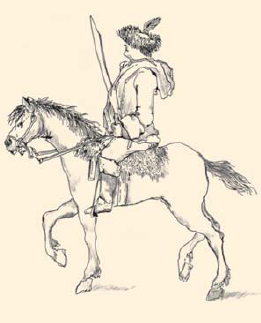
All members of the last Jacobite army wore elements of Scottish dress, as seen in this illustration of a Scotch Hussar with a plaid wrapped around his body.
The Act was not, as is often claimed, an expression of spite against the Highland clans. In point of fact comparatively few Highlanders had actually joined in the rebellion. Fully as many clansmen had instead marched under King George’s banner in the ranks of the famous Argyle Militia or the Highland Independent companies and the other Loyalist militias. The Act of Proscription was intended not to assist in the destruction of the Clan system but rather to bar overt political displays of tartan not as a Jacobite but as a nationalist symbol.
That the Act should eventually be repealed on 1 July 1782, rather than simply mouldering on the statute book, was a reflection of a growing reassertion in the meantime of a distinct Scottish identity within the Union, and a corresponding effort on the part of those Scots who supported it to ensure that it was to be properly recognised as a political marriage between equals; as a true union rather than as a brutal takeover by the senior partner.
The Scots had no qualms about serving in a British army and they were already positioning themselves to play the leading role in the creation of what would become the British Empire, but they were going to do it on their own terms – which included being accepted not as North Britons but as Scots. At the time of the Rising in 1745 there had been just two regular Highland regiments in the British Army: the Black Watch and the short-lived 64th Loudoun’s Highlanders. By the end of the century at least a further thirty regular Highland regiments would have been raised and nearly as many fencible or home service units. In fact during this period any regiment raised north of Stirling Castle was almost automatically designated as a Highland one, whether its men spoke Gaelic or Scots or came from Lochaber or Laurencekirk.
And all of them, like Hugh Montgomerie’s West Lowland Fencibles from Ayrshire and his Royal Glasgow Regiment, paraded and fought in blue bonnets, kilts or tartan trews to proclaim themselves ostentatiously as Scottish regiments.
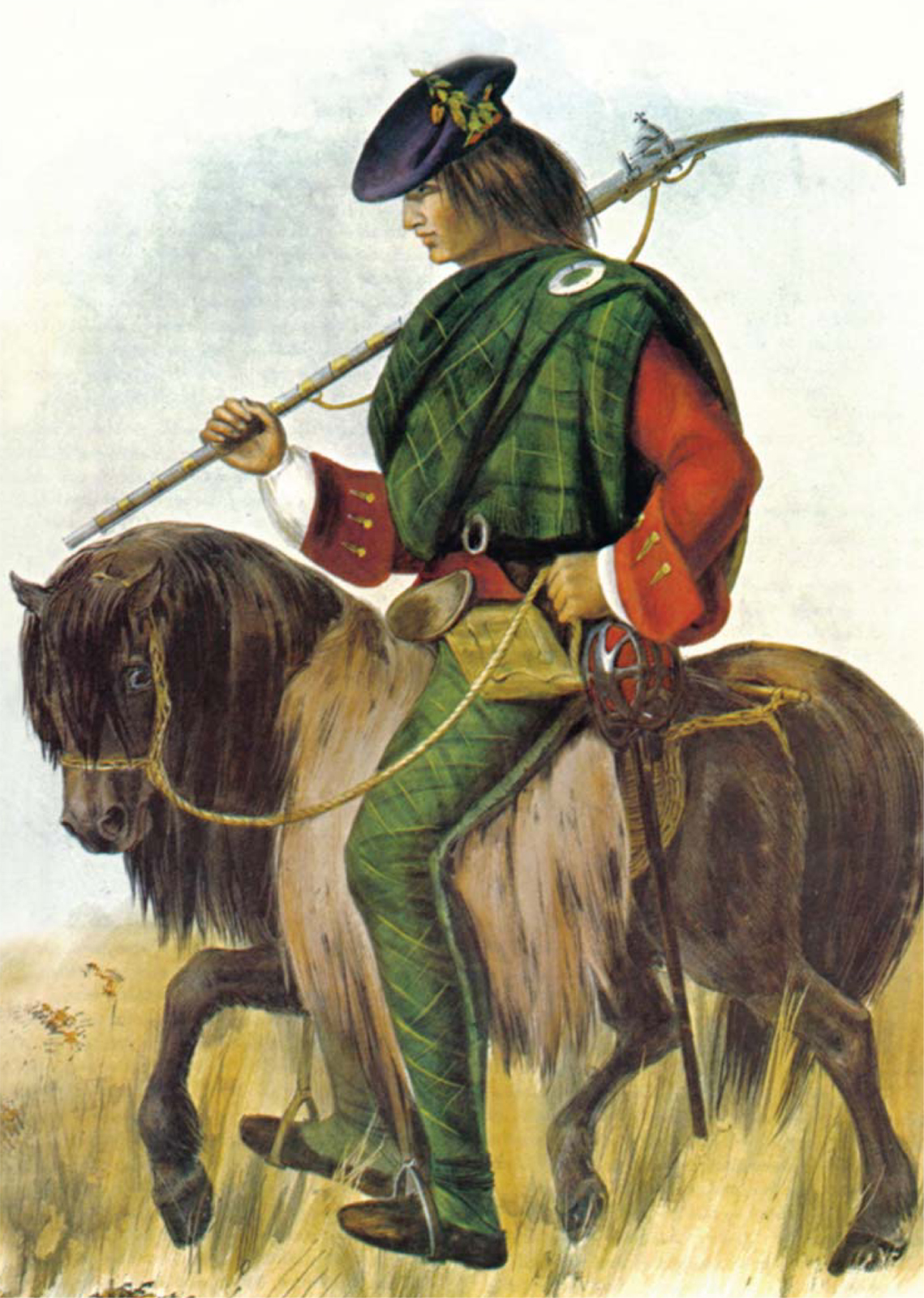
A delightful study by McIan of a highland gentleman riding a small pony. Some of the Marquis of Huntly’s ‘light horse’ at Sheriffmuir in 1715 were equally well mounted.